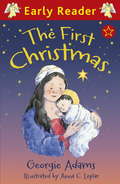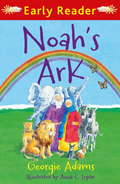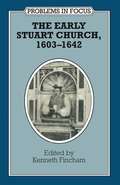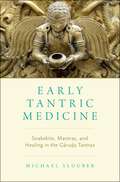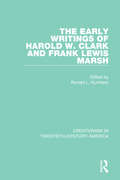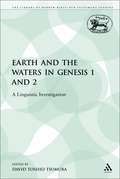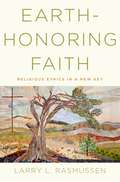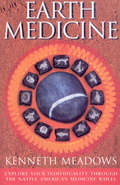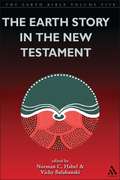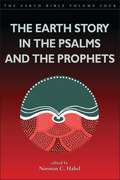- Table View
- List View
The Early Muslim Conquest of Syria: An English Translation of al-Azdī’s Futūḥ al-Shām (Culture and Civilization in the Middle East)
by Hamada HassaneinThis book narrates the battles, conquests and diplomatic activities of the early Muslim fighters in Syria and Iraq vis-à-vis their Byzantine and Sasansian counterparts. It is the first English translation of one of the earliest Arabic sources on the early Muslim expansion entitled Futūḥ al-Shām (The Conquests of Syria). The translation is based on the Arabic original composed by a Muslim author, Muḥammad al-Azdī, who died in the late 8th or early 9th century C.E. A scientific introduction to al-Azdīʼs work is also included, covering the life of the author, the textual tradition of the work as well as a short summary of the textʼs train of thought. The source narrates the major historical events during the early Muslim conquests in a region that covers today’s Lebanon, Israel, Palestinian Territories, Jordan, Syria, Turkey and Iraq in the 7th century C.E. Among these events are the major battles against the Byzantines, such as the Battles of Ajnādayn and al-Yarmūk, the conquests of important cities, including Damascus, Jerusalem and Caesarea, and the diplomatic initiatives between the Byzantines and the early Muslims. The narrative abounds with history and Islamic theological content. As the first translation into a European language, this volume will be of interest to a wide range of readership, including (Muslim and Christian) theologians, historians, Islamicists, Byzantinists, Syrologists and (Arabic) linguists.
The Early Muslim Conquest of Syria: An English Translation of al-Azdī’s Futūḥ al-Shām (Culture and Civilization in the Middle East)
by Hamada HassaneinThis book narrates the battles, conquests and diplomatic activities of the early Muslim fighters in Syria and Iraq vis-à-vis their Byzantine and Sasansian counterparts. It is the first English translation of one of the earliest Arabic sources on the early Muslim expansion entitled Futūḥ al-Shām (The Conquests of Syria). The translation is based on the Arabic original composed by a Muslim author, Muḥammad al-Azdī, who died in the late 8th or early 9th century C.E. A scientific introduction to al-Azdīʼs work is also included, covering the life of the author, the textual tradition of the work as well as a short summary of the textʼs train of thought. The source narrates the major historical events during the early Muslim conquests in a region that covers today’s Lebanon, Israel, Palestinian Territories, Jordan, Syria, Turkey and Iraq in the 7th century C.E. Among these events are the major battles against the Byzantines, such as the Battles of Ajnādayn and al-Yarmūk, the conquests of important cities, including Damascus, Jerusalem and Caesarea, and the diplomatic initiatives between the Byzantines and the early Muslims. The narrative abounds with history and Islamic theological content. As the first translation into a European language, this volume will be of interest to a wide range of readership, including (Muslim and Christian) theologians, historians, Islamicists, Byzantinists, Syrologists and (Arabic) linguists.
Early Nineteenth-Century Panjab
by J. S. Grewal Indu BangaThe Chār Bāgh-i-Panjāb, written by Ganesh Das Wadera immediately after the annexation of the Lahore kingdom by the British in 1849, is a classic Persian text. Its long descriptive part is the only surviving account of the social, religious, and cultural life of the peoples of the Punjab, especially during the late-eighteenth and the early-nineteenth century. Ganesh Das writes about traditional learning, literature, folklore, urban centres, and women with a rare catholicity as an Indian, an orthodox Hindu, a Punjabi, and a Khatri. Himself a hereditary qanungo of Gujrat in the Sikh kingdom, he also provides valuable insights into the structure of revenue administration at lower rungs. This volume presents an authoritative English translation of this primary descriptive section of Chār Bāgh-i-Panjāb, with a detailed Introduction, critical commentary, glossary, map, and a classified index. Indispensable for researchers, it will interest historians of medieval and modern India, especially those concerned with the pre-Independence Punjab region.
Early Nineteenth-Century Panjab
by J. S. Grewal Indu BangaThe Chār Bāgh-i-Panjāb, written by Ganesh Das Wadera immediately after the annexation of the Lahore kingdom by the British in 1849, is a classic Persian text. Its long descriptive part is the only surviving account of the social, religious, and cultural life of the peoples of the Punjab, especially during the late-eighteenth and the early-nineteenth century. Ganesh Das writes about traditional learning, literature, folklore, urban centres, and women with a rare catholicity as an Indian, an orthodox Hindu, a Punjabi, and a Khatri. Himself a hereditary qanungo of Gujrat in the Sikh kingdom, he also provides valuable insights into the structure of revenue administration at lower rungs. This volume presents an authoritative English translation of this primary descriptive section of Chār Bāgh-i-Panjāb, with a detailed Introduction, critical commentary, glossary, map, and a classified index. Indispensable for researchers, it will interest historians of medieval and modern India, especially those concerned with the pre-Independence Punjab region.
Early Phenomenology: Metaphysics, Ethics, and the Philosophy of Religion (Bloomsbury Studies in Continental Philosophy)
by Brian Harding Michael R. KellyTaking the term "phenomenologist†? in a fairly broad sense, Early Phenomenology focuses on those early exponents of the intellectual discipline, such as Buber, Ortega and Scheler rather than those thinkers that would later eclipse them; indeed the volume precisely means to bring into question what it means to be a phenomenologist, a category that becomes increasingly more fluid the more we distance ourselves from the gravitational pull of philosophical giants Husserl and Heidegger. In focusing on early phenomenology this volume seeks to examine the movement before orthodoxies solidified. More than merely adding to the story of phenomenology by looking closer at thinkers without the same fame as Husserl or Heidegger and the representatives of their legacy, the essays relate to one of the earlier thinkers with figures that are either more contemporary or more widely read, or both. Beyond merely filling in the historical record and reviving names, the chapters of this book will also give contemporary readers reasons to take these figures seriously as phenomenologists, radically reordering of our understanding of the lineage of this major philosophical movement.
Early Phenomenology: Metaphysics, Ethics, and the Philosophy of Religion (Bloomsbury Studies in Continental Philosophy)
by Brian Harding Michael R. KellyTaking the term “phenomenologist” in a fairly broad sense, Early Phenomenology focuses on those early exponents of the intellectual discipline, such as Buber, Ortega and Scheler rather than those thinkers that would later eclipse them; indeed the volume precisely means to bring into question what it means to be a phenomenologist, a category that becomes increasingly more fluid the more we distance ourselves from the gravitational pull of philosophical giants Husserl and Heidegger. In focusing on early phenomenology this volume seeks to examine the movement before orthodoxies solidified. More than merely adding to the story of phenomenology by looking closer at thinkers without the same fame as Husserl or Heidegger and the representatives of their legacy, the essays relate to one of the earlier thinkers with figures that are either more contemporary or more widely read, or both. Beyond merely filling in the historical record and reviving names, the chapters of this book will also give contemporary readers reasons to take these figures seriously as phenomenologists, radically reordering of our understanding of the lineage of this major philosophical movement.
Early Reader: (early Reader) (Early Reader)
by Georgie AdamsEarly Readers are stepping stones from picture books to reading books. A blue Early Reader is perfect for sharing and reading together. A red Early Reader is the next step on your reading journey.The story of the birth of Jesus and the first Christmas re-told with delightful simplicity, and illustrated with charming soft watercolours. Both text and pictures are designed to make this the perfect introduction to the Nativity story for very young children.
Early Reader: Noah's Ark
by Georgie AdamsEarly Readers are stepping stones from picture books to reading books. A blue Early Reader is perfect for sharing and reading together. A red Early Reader is the next step on your reading journey. Georgie Adams' retelling of the story of Noah and the flood is written with delightful simplicity, and illustrated with charming soft watercolours in this full colour book, perfect for Early Readers.
The Early Reception of Paul the Second Temple Jew: Text, Narrative and Reception History (The Library of Second Temple Studies #92)
by Isaac W. Oliver Gabriele BoccacciniPaul's relationship to Christianity-as a Pharisaic Jew whose moment of revelation on the road to Damascus has made him the most famous early Christian-is still a topic of great interest to scholars of early Christianity and Judaism. This collection of essays from world-renowned scholars examines how Christians of the first two centuries perceived Paul's Jewishness, and how they seized upon Paul's views on Judaism in order to advance their own claims about Christianity.The contributors offer a comprehensive examination of various early Christian views on Paul, in texts contained both in and outside of the New Testament, demonstrating how the reception of Paul's thought affected the formation of Judaism and Christianity into separate entities. Divided into five sections, the arguments focus upon Paul's reception in Ephesians, the other Deutero-Pauline Epistles, the Acts of the Apostles, Marcion of Synope and the reaction of Paul's opponents. Featuring essays from scholars including Judith Lieu, James H. Charlesworth and Harry O. Meier, this volume forms a perfect resource for scholars to reassess Paul's Jewishness and relationship with Judaism.
The Early Reception of Paul the Second Temple Jew: Text, Narrative and Reception History (The Library of Second Temple Studies)
by Isaac W. Oliver Gabriele Boccaccini Joshua ScottPaul's relationship to Christianity-as a Pharisaic Jew whose moment of revelation on the road to Damascus has made him the most famous early Christian-is still a topic of great interest to scholars of early Christianity and Judaism. This collection of essays from world-renowned scholars examines how Christians of the first two centuries perceived Paul's Jewishness, and how they seized upon Paul's views on Judaism in order to advance their own claims about Christianity.The contributors offer a comprehensive examination of various early Christian views on Paul, in texts contained both in and outside of the New Testament, demonstrating how the reception of Paul's thought affected the formation of Judaism and Christianity into separate entities. Divided into five sections, the arguments focus upon Paul's reception in Ephesians, the other Deutero-Pauline Epistles, the Acts of the Apostles, Marcion of Synope and the reaction of Paul's opponents. Featuring essays from scholars including Judith Lieu, James H. Charlesworth and Harry O. Meier, this volume forms a perfect resource for scholars to reassess Paul's Jewishness and relationship with Judaism.
The Early Stuart Church, 1603–1642 (Problems in Focus)
This volume takes a fresh look at the recent controversy over the character of the Early Stuart Church. The rival beliefs and practices of both clergy and laity are explored in a wide-ranging collection of original essays which investigate complementary themes including the royal supremacy, episcopal government, parish religion and theological disputes. Each is firmly grounded in its political and social context. Among the contributors are several leading figures in the current academic debates, as well as a number of younger scholars presenting their ideas for the first time.
Early Tantric Medicine: Snakebite, Mantras, and Healing in the Garuda Tantras
by Michael SlouberSnakebite may sound like a rare and exotic phenomenon, but in India it is a problem that affects 1.4 million people every year and results in over 45,000 deaths. A traditional medical system that flourished over 1,000 years ago, the Garuda Tantras had a powerful influence on medicine for snakebite, and some of their practices remain popular to this day. In Early Tantric Medicine, Michael Slouber offers a close examination of the Garuda Tantras, which were deemed lost until the author discovered numerous ancient titles surviving in Sanskrit manuscripts written on fragile palm-leaves. The volume brings to life this rich tradition in which knowledge and faith are harnessed in complex visualizations accompanied by secret mantras to an array of gods and goddesses; this religious system is combined with herbal medicine and a fascinating mix of lore on snakes, astrology, and healing. The book's appendices include an accurate yet readable translation of ten chapters of the most significant Tantric medical text to be recovered: the Kriyakalagunottara. Also included is a critical edition based on the surviving Nepalese manuscripts. Tying in to interest in holistic medicine, meditation, and Tantra, this volume sheds light on a nearly forgotten piece of history.
Early Tantric Medicine: Snakebite, Mantras, and Healing in the Garuda Tantras
by Michael SlouberSnakebite may sound like a rare and exotic phenomenon, but in India it is a problem that affects 1.4 million people every year and results in over 45,000 deaths. A traditional medical system that flourished over 1,000 years ago, the Garuda Tantras had a powerful influence on medicine for snakebite, and some of their practices remain popular to this day. In Early Tantric Medicine, Michael Slouber offers a close examination of the Garuda Tantras, which were deemed lost until the author discovered numerous ancient titles surviving in Sanskrit manuscripts written on fragile palm-leaves. The volume brings to life this rich tradition in which knowledge and faith are harnessed in complex visualizations accompanied by secret mantras to an array of gods and goddesses; this religious system is combined with herbal medicine and a fascinating mix of lore on snakes, astrology, and healing. The book's appendices include an accurate yet readable translation of ten chapters of the most significant Tantric medical text to be recovered: the Kriyakalagunottara. Also included is a critical edition based on the surviving Nepalese manuscripts. Tying in to interest in holistic medicine, meditation, and Tantra, this volume sheds light on a nearly forgotten piece of history.
The Early Text Of The New Testament: (pdf)
by Charles E. Hill Michael J. KrugerThe Early Text of the New Testament aims to examine and assess from our earliest extant sources the most primitive state of the New Testament text now known. What sort of changes did scribes make to the text? What is the quality of the text now at our disposal? What can we learn about the nature of textual transmission in the earliest centuries? In addition to exploring the textual and scribal culture of early Christianity, this volume explores the textual evidence for all the sections of the New Testament. It also examines the evidence from the earliest translations of New Testament writings and the citations or allusions to New Testament texts in other early Christian writers.
The Early Text of the New Testament
by Charles E. Hill Michael J. KrugerThe Early Text of the New Testament aims to examine and assess from our earliest extant sources the most primitive state of the New Testament text now known. What sort of changes did scribes make to the text? What is the quality of the text now at our disposal? What can we learn about the nature of textual transmission in the earliest centuries? In addition to exploring the textual and scribal culture of early Christianity, this volume explores the textual evidence for all the sections of the New Testament. It also examines the evidence from the earliest translations of New Testament writings and the citations or allusions to New Testament texts in other early Christian writers.
The Early Upanishads: Annotated Text and Translation (South Asia Research)
by Patrick OlivelleThis is the full edition of the early Upanisads, the central scriptures of Hinduism. Featuring Patrick Olivelle's acclaimed new English translation (Oxford, 1996), it also includes the complete Sanskrit text, as well as variant readings, scholarly emendations, and explanations of Olivelle's choices of particular readings. The volume also contains a concordance of the two recensions of the Brhadaranyaka Upanisad, and an extensive bibliography.
The Early Writings of Harold W. Clark and Frank Lewis Marsh
by Ronald L. NumbersOriginally published in 1995, The Early Writings of Harold W. Clark and Frank Lewis Marsh is the eighth volume in the Creationism in Twentieth Century America series, reissued in 2019. The book is a collection of original writings by the prominent creationist Harold W. Clark, and the biologist, educator and young Earth creationist Frank Lewis Marsh. Although both were significant figures in the anti-evolutionist movement of the early 20th century, unlike other members of the movement, both Marsh and Clarke were trained scientists studying under eminent evolutionists of the time. Both writers struggled to reconcile new scientific understandings of geology, botany and palaeontology, supported by Darwin’s theory of evolution, with their own creationist beliefs in genesis and flood theory. Both scientists as such began to develop their own theories of evolution that remained in line with creationist beliefs. This compact and unique collection includes the writings of Marsh and Clark from this period, featuring some of their well-known works on the subject including ‘Back to Creation’ and ‘Fundamental Biology’. This volume of original sources will be of interest to academics of religion, natural history and historians of the 19th century.
The Early Writings of Harold W. Clark and Frank Lewis Marsh
by Ronald L. NumbersOriginally published in 1995, The Early Writings of Harold W. Clark and Frank Lewis Marsh is the eighth volume in the Creationism in Twentieth Century America series, reissued in 2019. The book is a collection of original writings by the prominent creationist Harold W. Clark, and the biologist, educator and young Earth creationist Frank Lewis Marsh. Although both were significant figures in the anti-evolutionist movement of the early 20th century, unlike other members of the movement, both Marsh and Clarke were trained scientists studying under eminent evolutionists of the time. Both writers struggled to reconcile new scientific understandings of geology, botany and palaeontology, supported by Darwin’s theory of evolution, with their own creationist beliefs in genesis and flood theory. Both scientists as such began to develop their own theories of evolution that remained in line with creationist beliefs. This compact and unique collection includes the writings of Marsh and Clark from this period, featuring some of their well-known works on the subject including ‘Back to Creation’ and ‘Fundamental Biology’. This volume of original sources will be of interest to academics of religion, natural history and historians of the 19th century.
The Earth and the Waters in Genesis 1 and 2: A Linguistic Investigation (The Library of Hebrew Bible/Old Testament Studies)
by David Toshio TsumuraEnormous amounts of interpretive efforts have gone into the first book of the Hebrew Bible. In modern critical studies of Genesis, for instance, it is often suggested that the nature of the "earth-waters" relationship in Chapter 1 is totally different from that in Chapter 2. Professor Tsumura here offers a linguistic analysis of some key terms related to the initial situation of the earth in its relationship with the waters in Gen 1:2 and Gen 2:5ff that helps to clarify some of the hermeneutic issues at stake.
Earth-honoring Faith: Religious Ethics in a New Key
by Larry L. RasmussenGrand Winner of the 2014 Nautilus Book Awards Thoughtful observers agree that the planetary crisis we now face-climate change; species extinction; the destruction of entire ecosystems; the urgent need for a more just economic-political order-is pushing human civilization to a radical turning point: change or perish. But precisely how to change remains an open question. In Earth-honoring Faith, Larry Rasmussen answers that question with a dramatically new way of thinking about human society, ethics, and the ongoing health of our planet. Rejecting the modern assumption that morality applies to human society alone, Rasmussen insists that we must derive a spiritual and ecological ethic that accounts for the well-being of all creation, as well as the primal elements upon which it depends: earth, air, fire, water, and sunlight. He argues that good science, necessary as it is, will not be enough to inspire fundamental change. We must draw on religious resources as well to make the difficult transition from an industrial-technological age obsessed with consumption to an ecological age that restores wise stewardship of all life. Earth-honoring Faith advocates an alliance of spirituality and ecology, in which the material requirements for planetary life are reconciled with deep traditions of spirituality across religions, traditions that include mysticism, sacramentalism, prophetic practices, asceticism, and the cultivation of wisdom. It is these shared spiritual practices that can produce a chorus of world faiths to counter the consumerism, utilitarianism, alienation, oppression, and folly that have pushed us to the brink. Written with passionate commitment and deep insight, Earth-honoring Faith reminds us that we must live in the present with the knowledge that the eyes of future generations will look back at us.
EARTH-HONORING FAITH C: Religious Ethics in a New Key
by Larry L. RasmussenGrand Winner of the 2014 Nautilus Book Awards Thoughtful observers agree that the planetary crisis we now face-climate change; species extinction; the destruction of entire ecosystems; the urgent need for a more just economic-political order-is pushing human civilization to a radical turning point: change or perish. But precisely how to change remains an open question. In Earth-honoring Faith, Larry Rasmussen answers that question with a dramatically new way of thinking about human society, ethics, and the ongoing health of our planet. Rejecting the modern assumption that morality applies to human society alone, Rasmussen insists that we must derive a spiritual and ecological ethic that accounts for the well-being of all creation, as well as the primal elements upon which it depends: earth, air, fire, water, and sunlight. He argues that good science, necessary as it is, will not be enough to inspire fundamental change. We must draw on religious resources as well to make the difficult transition from an industrial-technological age obsessed with consumption to an ecological age that restores wise stewardship of all life. Earth-honoring Faith advocates an alliance of spirituality and ecology, in which the material requirements for planetary life are reconciled with deep traditions of spirituality across religions, traditions that include mysticism, sacramentalism, prophetic practices, asceticism, and the cultivation of wisdom. It is these shared spiritual practices that can produce a chorus of world faiths to counter the consumerism, utilitarianism, alienation, oppression, and folly that have pushed us to the brink. Written with passionate commitment and deep insight, Earth-honoring Faith reminds us that we must live in the present with the knowledge that the eyes of future generations will look back at us.
Earth Medicine: Explore Your Individuality Through the Native American Medicine Wheel (Earth Quest Ser.)
by Kenneth MeadowsNative Americans had a close affinity with the earth and an understanding of the natural forces which shaped their environment. They recognised that not only were our physical bodies composed of the elements of the earth but our core personalities also were influenced by seasonal characteristics and by the tides of time governed by the Sun and the Moon.The time of birth was no chance happening of fate, but an indication of personality traits and inherent potentials we were each born with to meet the challenges of life. The key to exploring your individuality is a Birth Totem - an animal representation which indicates the characteristics and attributes which combined together comprise your 'medicine' - your inner power and resources.Learn how to:- Identify your own Birth Totem- Connect yourself to your true potential- Discover your life purpose and learn how to fulfil it- Explore all aspects of your life including health and relationships.
Earth Story in Genesis: Volume 2
by Norman C. Habel Shirley WurstA series of articles by scholars from around the world reading the story of Earth in Genesis in the light of the ecojustice principles enunciated in Volume One, 'Readings from the Perspective of Earth'. These readings uncover how Earth may be valued or de-valued, given a voice or denied a voice, dominated or served, depending on the orientation of the text. In Genesis 1, for example, the intrinsic worth of Earth is highlighted in the 'revealing' of Earth's presence but negated when humans are given the right to 'subdue' it. In Genesis 9 the text begins with the Earth community terrified by, and alienated from, humans but ends with all the Earth Community-and Earth itself-bound together equally in a covenant.
The Earth Story in the New Testament: Volume 5
by Vicky Balabanski Norman C. HabelThe "Earth Bible" is an international project, including volumes on ecojustice readings of major sections of the Bible. The basic aims of the Earth Bible project are: to develop ecojustice principles appropriate to an Earth hermeneutic for interpreting the Bible and for promoting justice and healing for Earth; to publish these interpretations as contributions to the current debate on ecology, ecoethics and ecotheology; to provide a responsible forum within which the suppressed voice of Earth may be heard and impulses for healing Earth may be generated. The project explores text and tradition from the perspective of Earth, employing a set of ecojustice principles developed in consultation with ecologists, suspecting that the text and/or its interpreters may be anthropocentric and not geocentric, but searching to retrieve alternative traditions that hear the voice of Earth and value Earth as more than a human instrument. The lead article in Volume V is a reflection in responses to the ecojustice principles employed in the hermeneutic of the project. Several articles offer insights into New Testament texts that seem to devalue Earth in favour of heaven. The final article by Barbara Rossing challenges the popular apocalyptic notion that in the new age Earth will be terminated. A feature of this volume is a dialogue between Norman Habel, who argues that John One seems to devalue Earth, and two respondents, Elaine Wainwright and Vicky Balabanski (who is coeditor of this volume with Norman Habel). 1
Earth Story in the Psalms and the Prophets
by Norman C. HabelIn this volume, scholars from around the world read the story of Earth in key texts from the Psalms and the Prophets.Their readings challenge popular understandings of the Chaoskampf myth, the theophany of Psalm 29 and the New Earth in Isaiah 65. Re-readings of Ezekiel expose the cruelty of divine justice extended to the natural world. Several articles by indigenous writers sensitive to the voice of Earth bring new insights to the potential meaning of texts like Psalm 104. Contributors include Lloyd Geering, Russell Nelson, William Urbrock, Laurie Braaten, Keith Carley, Anne Gardner, John Olley, Gunther Wittenberg, Kalinda Stevenson, Peter Trudinger, Arthur Walker-Jones, Norman Charles, Howard Wallace, Geraldine Avent, Madipoane Masenya and Abotchie Ntreh.



